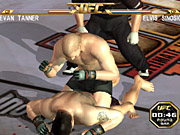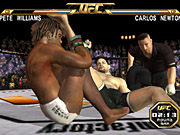The mixed-martial-arts genre got its start on the Dreamcast, when Crave and Anchor teamed up to release the first Ultimate Fighting Championship game in 2000. The game did a terrific job at staying somewhat true to the subject matter while delivering a fun, easy-to-learn fighting game. Anchor has since gone on to produce Pride FC for the PlayStation 2, a similar game that refined the genre a bit and featured a few new modes. TDK has since picked up the UFC torch and delivered UFC: Tapout 2 on the Xbox. While the game has a nice look to it and plays just fine, it doesn't really stray too far from the series' original design, and as such it feels like the same thing we've been playing for three years.

Tapout 2's gameplay is more or less identical to that of the previous games in the series. Each of the controller's four face buttons controls one of your fighter's limbs, and you can combine button presses to counter incoming strikes, use grappling techniques, and attempt to end the bout with a submission move. The main difference is that a few new positions and situations have been added. Also, the game's AI is woefully unprepared to deal with even the most basic attack patterns on its default setting. Given the nature of some of the game's quick punch combos, it's possible to win almost every fight by using one three-punch combo over and over again. Bumping up the difficulty helps a bit, but it doesn't eliminate the problem completely.
Graphically, Tapout 2 has an interesting look to it. The fighters, ring, and surrounding items are rendered on the fly, but the crowd actually appears to consist of prerendered video clips. This makes the crowd look more active and realistic than most game audiences, but it's also a somewhat weird-looking contrast to the action in the ring. The game's fighter models look nice, but the animation isn't so hot. Much of it appears to have been taken from the previous games in the series, and the nicer-looking models make the sketchy animation stand out more than it has in previous incarnations.

Overall, UFC: Tapout 2 has some strengths, but they're the same strengths that the previous Tapout game had. The game doesn't really bring anything new to the genre, and the game's AI flaws make it a very dull single-player experience. Even devout fans of the sport would be better off with the previous Tapout game, or, if they own a PlayStation 2, THQ's Pride FC.